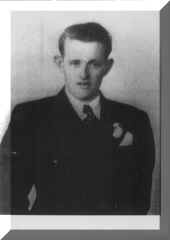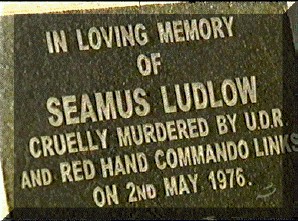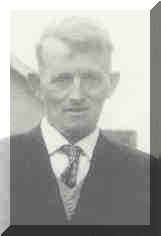


The Murder of Seamus Ludlow in County Louth, May 1976. Towards a public inquiry?
  
The Murder of Seamus Ludlow in County Louth, May 1976. Towards a public inquiry? |
|
Indeed, the late Kevin Donegan and his wife Kathleen, a sister of Seamus Ludlow's, who lived at Dromintee, just across the border in south Armagh, had an ominous experience in the days after the murder of Seamus Ludlow which pointed to an unexplained interest in a crime which should have been none of their business. Sadly, Kevin Donegan passed away on 27 January 1992, aged 72 years, without ever knowing the true nature of the cover-up which followed the murder of his brother-in-law Seamus Ludlow. He had been told cruel lies by members of the gardai, who tried to use him as a means for splitting the Ludlow family. Mr. Donegan also had a strange, and dangerous, encounter with the British Army after Seamus Ludlow's murder which has never been explained to the Ludlow-Donegan family circle. A recent internal Garda investigation led by Chief Superintendent Ted Murphy and the inquiries by Mr Justice Henry Barron have failed to find answers requested by the Donegan family. A number of British soldiers called to the Donegan family home a few days after the murder. It was the day after Seamus Ludlow was laid to rest. Being met by Mr. Donegan the British soldiers asked to speak to Mrs. Kathleen Donegan. They said that they were sent by the RUC to make enquiries about the recent murder of her brother Seamus Ludlow. They then made a number of offensive statements to Mrs. Donegan about her dead brother, to the effect that he must have done something to deserve it because the IRA would not have killed him for nothing, and things like that. Mr.
Donegan, who is pictured here, told the British soldiers to go away.
They were not going to answer any questions about a matter which was
none of their business. They were not police and besides the crime was
committed in another jurisdiction. After insisting that they required
answers to certain questions and meeting refusal, the soldiers
eventually departed. Right: This is a photograph of the late Kevin Donegan who was abducted and interrogated by the British Army after the murder of his brother-in-law Seamus Ludlow. Mr. Donegan then got on a bicycle and went to the local Forkhill RUC/British Army base to demand an explanation for the British Army's behavior from the RUC. However, there were no RUC officers there, and Mr. Donegan was put aboard a British military helicopter and flown to the Bessbrook Mill British Army Base, where he was questioned for a time by a British Army Intelligence officer. The officer was particularly interested in the line of inquiry being taken by the Gardai in Dundalk. In 1998, Kathleen Donegan, a sister of Seamus Ludlow, gave the following account of her late husband's abduction by the British Army in a statement to Garda Chief Superintendent Ted Murphy: "The man in charge said to me and my husband, 'Seamus Ludlow must be a very bad man: the IRA usually kneecap people, but this time they killed him.' I said 'It was not the IRA who killed him; you know who did it.' My husband ordered them out the gate: the man in charge said, 'If you don't talk to us you will talk to the police.' They told him to go to the police, the police at Forkhill. "My husband then cycled to Forkhill RUC station but there were no police officers there at the time. He was again met by the British Army who took him to Bessbrook by helicopter. He was taken from there by car to Newry RUC station and was questioned by a British Army intelligence officer for three hours. An RUC man in the station said to my husband that it was not them who sent the soldiers to our house." (From the Barron Report, page 60) Meanwhile, Mrs. Donegan grew concerned when her husband did not return as expected within the hour. She rang Fork hill Barracks, and was told that her husband was not there, before contacting her local elected representative, Councillor Jim Murphy (now deceased), who was an elected member of the Newry and Mourne District Council. Mr Murphy was very helpful. He made inquiries as to her husband's whereabouts. Eventually, Mr. Murphy discovered Mr. Donegan's whereabouts. He drove to Bessbrook and secured Mr. Donegan's release from British Army custody. The British Army has never explained its interest in the murder of Seamus Ludlow. The Ludlow family is perhaps entitled to suspect that elements within the British Army must have known something about the terrible event that had transpired across the border on the night of the 1st and 2nd May 1976. Were they engaged in a clumsy cover-up of something of which the British Army had prior knowledge, perhaps a spying or assassination mission in the town of Dundalk? This British Army interest in the murder of Seamus Ludlow remained private within the Ludlow-Donegan family for many years until it was reported for the first time by the noted human rights activist, Fr Raymond Murray in his book The SAS in Ireland, which was published in 1989. (The Mercier Press, Cork - ISBN 0 85342 938 3) No member of the Donegan family had communicated the events of that day in May 1976 to Fr Murray. Indeed no member of the Donegan family had any contact with him until some years later, in 1998, when he at once threw his full support into the Ludlow family's call for full truth and justice. It is assumed that the now Monsignor Murray must have heard of the late Mr. Donegan's experience of British Army interrogation from the late Jim Murphy.
Certainly the above mentioned events involving the late Kevin Donegan illustrate a number of things about British Army activities. It appears that they knew very soon after the murder was committed that Seamus Ludlow had a sister in Dromintee. Their alleged action in support of the Royal Ulster Constabulary (RUC) also appears bogus since from that day to this the RUC has never contacted Mrs. Kathleen Donegan or anyone in her family at Dromintee about the murder of Seamus Ludlow. It seems that the British Army had its own interest in the murder of Seamus Ludlow and it was the view of all in the Donegan family that the British Army was engaged in a clumsy attempt to cover-up its own apparent involvement in the events of 1 May 1976 or to find out if its cover had been blown. Knowing their murdered relative to have been an entirely blameless and decent man who had no involvement in the unstable political situation in the Six Counties, the Ludlow family circle has continually proclaimed his innocence and demanded justice. The Ludlow family circle is now aware that the police on both sides of the Irish border had identified the real killers very soon after the crime was committed. They did nothing to bring the killers to justice while they continued to lie to the family about the lack of new evidence pointing to the involvement of others. The Ludlow family circle's long-held suspicions about an official cover-up of the crime were finally confirmed after 22 years with the arrest by the Northern Ireland police, the RUC, of four Loyalist suspects from the Comber-Newtownards district of North County Down, in February 1998. It has emerged that the suspects include three members of the illegal Protestant murder gang Red Hand Commando, which is an offshoot of the equally murderous Ulster Volunteer Force (UVF). Further, it is known that at least two of these men were members of the British Crown Forces at that time. Two of these men were members of the British Army's locally recruited and overwhelmingly Protestant and Loyalist militia the Ulster Defence Regiment (UDR), and one of these held the rank of Captain in that discredited regiment which is now called the Royal Irish Regiment (RIR). All four Loyalist suspects were released without charge, with an RUC investigation file being prepared for the Northern Ireland Director of Public Prosecutions (DPP). Almost a year to the day after receiving the RUC file, the Northern Ireland DPP informed the Ludlow family that none of the four loyalist suspects were to face charges for any offence, even though two of the suspects signed statements in which they implicated themselves and the others in the murder of Seamus Ludlow. The Ludlow family is entitled to speculate that it was the British Army's knowledge of these mens' activities which brought British soldiers to the Donegan family home and led to the abduction and interrogation of the late Kevin Donegan just days after the murder of his brother-in-law Seamus Ludlow. The abduction and interrogation of Kevin Donegan were examined by Mr Justice Henry Barron in the course of his private inquiry into the murder of Samus Ludlow. The inquiry has been unable to salvage an explanation for this incident. The Barron Report was finally published in November 2005. The inquiry wrote to the RUC on 21 May 2002, seeking any information on this incident it might have on its files. A memo from the RUC was then received with a letter from the northern Ireland secretary of state, dated 9 June 2003: "In relation to the questions posed concerning Kevin Donegan . . . no record has been uncovered of either an approach to him to attend Forkhill RUC station, or his being iterviewed there." The Inquiry again raised the matter with further correspondence with the British Northern Ireland Office (NIO). Justice Barron wrote: "You have already supplied information available to the Ministry of Defence. However, the RUC was in no way involved: the questioning was solely a matter for the British Army. The British Army was involved in three separate ways. Firstly, members of the British Army called to the home of Kevin Donegan and told him to report to Forkhill RUC station. Secondly, there were only British Army personnel at this station and they brought him to Bessbrook Army Barracks by helicopter. Thirdly, he was questioned for an hour by a British Army officer. The subject matter of the questioning related to what Mr Donegan knew about the line of inquiry being taken by An Garda Siochana. A local councillor, Jim Murphy arranged for him to return home. This same councillor had gone first to Forkhill RUC station where knowledge of Mr Donegan was denied. This series of events has serious connotations. The questioning may have been designed purely to add to the store of Army Intelligence relating to Loyalist subversive activity in the area. Nevertheless, there is the implication, believed by the family to be correct, that Army Intelligence was aware of the names of the culprits, and was not prepared to pass on that information to the RUC, unless the Gardai had evidence which they might pass on themselves. Such an inference would have gained strength when it was discovered that two members of the UDR were amongst the four names suspected of being involved, one of whom had actually fired the fatal shots. This is a serious allegation I pass on to you because I feel that it should be answered." This letter received only an unsatisfactory response, dated 6 July 2004, simply stating: "On the questioning of Kevin Donegan, the Ministry of DEfence has advised that no material was found on file to indicate that the Army questioned Mr Donegan." !n a letter dated 14 July 2004, the Inquiry again wrote to the British authorities: "In relation to the Army questioning of Kevin Donegan, I am surprised at the absence of Army records, which in both our jurisdictions seem to have been kept meticulously . . . As already referred to in my letter of 28 November 2003, the British Army personnel who came to his home must have been acting under orders. While no note might have been taken of his visit to Forkhill RUC station, Kevin Donegan was nevertheless brought to Bessbrook by helicopter, an interrogation took place at Bessbrook. Surely this fact, and the presence of a local councillor to arrange for his return home, would have been recorded." (Quotes from the Barron Report, pages 60-61) No reply was received before Mr Justice Barron completed his report. Mr Justice Barron gives the following conclusions in his report:
The late Kevin Donegan's experience with the British Army were related in open hearing to the Joint Oireachtas Sub-Committee on Justice by his son Michael in January 2006.
I Top I Download the Barron Report from the Oireachtas website (pdf file) SUPPORT THE SEAMUS LUDLOW APPEAL FUND Bank of Ireland 78 Clanbrassil Street Dundalk County Louth IrelandAccount No. 70037984 Thank You.
|